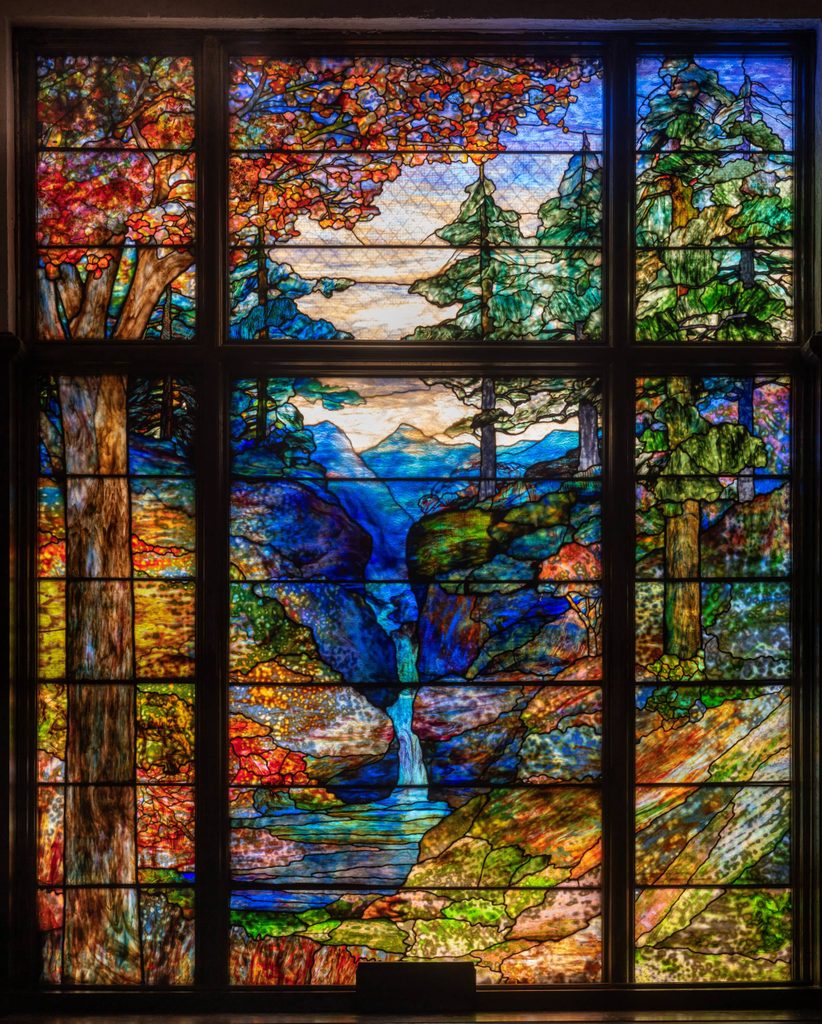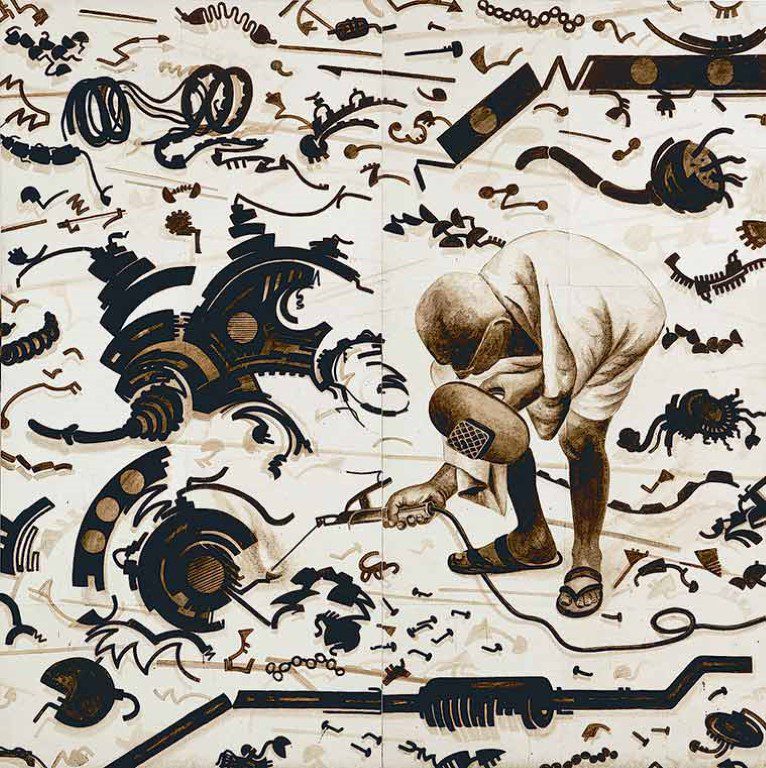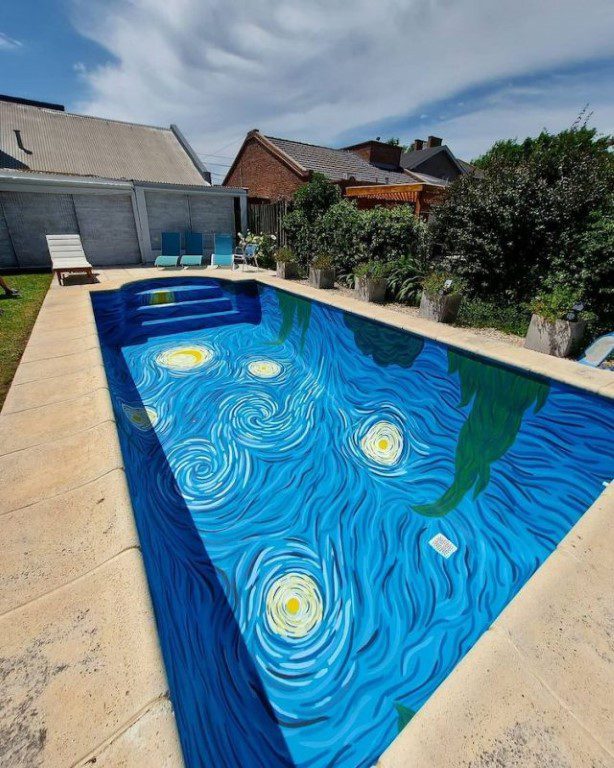A Luminous Masterpiece of American Stained Glass: Tiffany’s Mountain Landscape
In the world of American decorative arts, few creations capture the sublime intersection of craft, color, and nature as brilliantly as Mountain Landscape (Root Memorial Window), a monumental stained-glass window created by Tiffany Studios in 1917 and now a centerpiece in the permanent collection of the Crystal Bridges Museum of American Art in Bentonville, Arkansas.
Towering at 110×93 inches, this immersive composition is more than just glass and lead, it’s a spiritual landscape rendered in light. Attributed to the visionary designer Agnes F. Northrop, Mountain Landscape represents a pinnacle of the American Arts and Crafts movement, combining innovative material techniques with a reverent portrayal of nature.
An Artistic Vision in Glass: The Design of Mountain Landscape
The window’s design is a breathtaking scene: a waterfall cascades through a densely wooded glade, framed by ancient trees, distant blue mountains, and an overcast sky that glows with latent energy. Each landscape element has been articulated not with brush or pigment, but through layered and textured glass, hand-selected for its hue, opacity, and iridescence.\
Northrop, the lead landscape designer for Tiffany Studios, specialised in interpreting natural environments through glass. Her approach in Mountain Landscape is painterly, yet sculptural. The window conveys both depth and atmosphere, relying on Tiffany’s distinctive “plating” technique, in which multiple layers of glass are stacked together to create complexity of tone and dimension.
Unlike European stained glass, which often used surface painting, Tiffany’s American method infused the glass itself with colour, allowing for luminous effects that shift with the light. This technique is especially apparent in the ridged mountain peaks that recede in soft blue and violet tones—a masterstroke of atmospheric perspective rendered purely through glass layering.
Symphony of Technique: Glass as Medium, Not Canvas
The true genius of Mountain Landscape lies in its execution. Northrop’s design, brought to life by Tiffany’s artisans, makes full use of the studio’s glassmaking innovations. Every detail, the swirling currents of the waterfall, the canopy of golden leaves, the dappled forest floor, is achieved through advanced glasswork methods, including:
- Confetti glass: Small shards of multicoloured glass fused onto base layers to simulate the dappled textures of foliage.
- Rippled and drapery glass: Textured surfaces used for flowing water and tree bark, adding both visual and tactile depth.
- Mottled glass: A hallmark of Tiffany windows, used to suggest the ever-changing qualities of light and shadow in nature.
“When you see the work, that combination of the illumination from the back and the grand scale, it really immerses you,” said Jen Padgett, Windgate Curator of Craft at Crystal Bridges. “It’s just this amazing kaleidoscope of colour and texture.”
Light as the Final Ingredient
Perhaps the most essential “material” in Mountain Landscape is not glass, but light itself. The window was designed to be backlit, allowing sunlight, or now, carefully engineered artificial lighting, to bring its colours to life. At Crystal Bridges, a custom illumination system will replicate the changing quality of natural light throughout the day and across seasons, enhancing the window’s sensory impact.
Padgett notes, “The experience of seeing this work can also help you see paintings like Kindred Spirits or landscapes by Thomas Cole in new ways. It’s about how light, medium, and motif work together to evoke feeling.”
The immersive effect is one of sublime wonder. The window does not merely depict a forest glen, it becomes one, enveloping the viewer in the sanctity and serenity of nature.
The Artist Behind the Vision: Agnes F. Northrop
Though Tiffany Studios is often associated with its founder, Louis Comfort Tiffany, the creation of its most celebrated works was collaborative. Mountain Landscape bears the signature aesthetic of Agnes Northrop, one of the earliest and most influential women in American decorative arts.
Northrop’s work is also seen in masterworks like the Hartwell Memorial Window at the Art Institute of Chicago and Autumn Landscape at The Met. In each, she captures the untamed, emotional power of American scenery using only light, colour, and the inherent qualities of glass.
Her landscapes are not literal, they are emotive translations of nature, filtered through the soul of an artist who saw divinity in the outdoors.
A New Era of Preservation and Public Access
After nearly a century in the Fraser Chapel at Sunset Ridge Church in San Antonio, Texas, the Mountain Landscape window was gifted to Crystal Bridges for public preservation and display. It is now undergoing a meticulous conservation process led by Nzilani Glass Conservation in Oakland, California.
“Every single piece was so thoughtfully chosen and placed,” says conservator Ariana Makau. “We’re going to reveal a lot of the vibrancy that was lost over time.”
Layers of dirt from candle smoke and Texas dust are being gently removed; cracks are being restored with refractive epoxy; and no paint is required to return this masterpiece to its original glow, just skilled care, clean glass, and light.
Why Mountain Landscape Matters Today
In a moment when museums are reevaluating how and why art matters, Mountain Landscape stands as a beacon. It’s not simply a historical object, but a living encounter with nature, spirituality, and the democratic ideals of American craft. It bridges the sacred and the aesthetic, showing that great art can arise not from oil and canvas but from the collaboration of material, labour, and vision.
As Crystal Bridges prepares to unveil the window in 2026 within a newly expanded gallery, Mountain Landscape is poised to become more than a display, it is a pilgrimage. A glowing sanctuary that invites reflection, awe, and the profound sense that art, like nature, is something to be experienced with the whole self.
Art That Breathes with Light
Mountain Landscape by Tiffany Studios is not merely a stained-glass window; it is a testament to American ingenuity and reverence for the natural world. Through the hands of Agnes Northrop and Tiffany’s artisans, glass becomes poetry, light becomes brushstroke, and nature becomes sacred.
Now preserved and presented for future generations, this masterwork continues to shine, its story told not in words, but in the shifting light that dances across every pane.
Image – Mountain Landscape. Courtesy – Crystal Bridges Museum
Contributor





